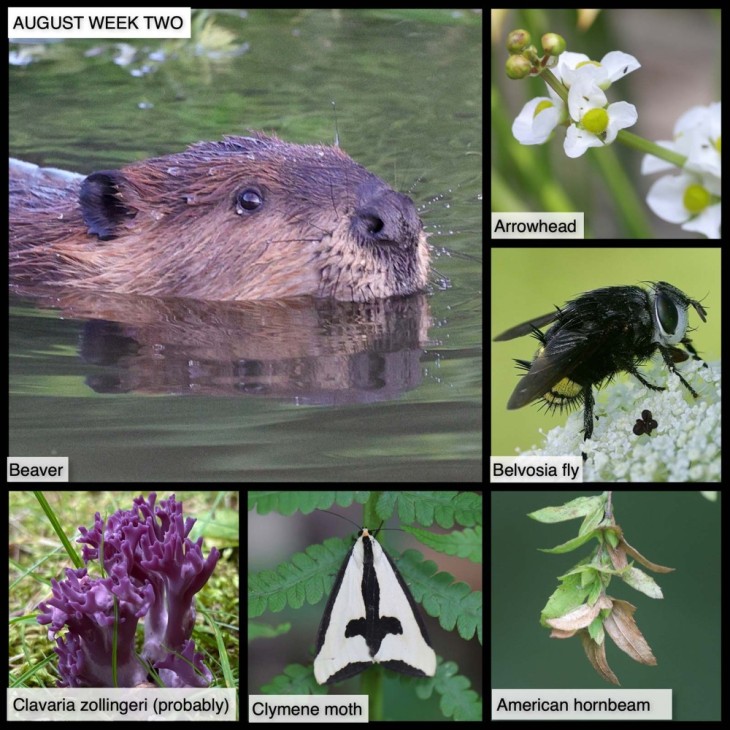This Week in the Woods, we encountered a beaver just as it clambered up from a lower impoundment and splashed back into the water. This is a fun time to visit a beaver pond, to observe how the animals have responded to all the recent rain by expanding their damming projects. The Northern Woodlands online archive has numerous articles about beavers, including this Outside Story essay by Declan McCabe describing their contributions as “landscape engineers.” For example, damming activities raise nearby groundwater levels, and when beavers move out of an area, they leave behind them carbon-rich meadows.
Here are some other nature sights this week (clockwise):
Arrowhead (multiple species, including the look-alikes common arrowhead and northern arrowhead) is blooming now in the marshes. We found an abundance of the flowers while kayaking on the Ompompanoosuc River. The plants, which also go by the name of duck potatoes, grow in the mud at the edges of wetlands as well as in submerged mud. Their starchy tubers are food for ducks and other wildlife. Here’s a profile of northern arrowhead from the U.S. Forest Service, which notes that individual plants can be monoecious (having both male and female reproductive structures) or dioecious (just one gender). It’s very uncommon for there to be that variation within one plant species.
Bee-like, bristly Belvosia flies are active in the meadow. They look alarming but the flies – part of the large tachinid group – are harmless to people and doing a service as pollinators. The fly in the photo is probably Belvosia borealis, which bugguide.net describes as a parasitoid of sphinx moths. Tachinid fly larvae make their living by infecting, and eating from the inside-out, other insects, often (depending on the fly species) caterpillars or beetle larvae.
American hornbeam’s seed clusters are dangling from twigs and their bracts are turning brown. This understory tree, which also goes by several other names including “musclewood,” has limited commercial value, but it benefits a variety of wildlife, including birds and rodents that feed on the seeds, and the eastern tiger swallowtail, which uses the tree as one of its caterpillar hosts. Here’s a profile from The Native Plant Trust.
We found this beautiful clymene moth in almost exactly the same spot we found one in late July 2020 – high up in a mix hardwood stand, clinging to a fern near a patch of white snakeroot. This location makes sense, because as noted on this page of bugguide.net (which also offers additional photos of the adult moths), white snakeroot and oaks are both host plants for clymene caterpillars.
Finally, although we’ve recently featured a photo of coral fungi, we couldn’t resist including this photo from assistant editor Meghan McCarthy McPhaul, showing purple coral (probably Clavaria zollingeri) that popped up unexpectedly near her home. According to Timothy Baroni, in Mushrooms of the United States and Eastern Canada, this species appears from July through September. It’s less abundant than some other corals, and a special find.
Our thanks to The Bailey Charitable Foundation and the Frank and Brinna Sands Foundation for helping to support this series.
In this difficult period, many of us find joy in observing local nature. This series, launched in April 2020, shares nature photographs taken in the past seven days, or in the same week in 2020, most within 15 miles of the Northern Woodlands office in Lyme, New Hampshire. We hope you enjoy using this grid as a prompt for your own explorations.
What are you seeing in the woods this week? Share your images with us on Facebook, or submit a special photo for possible inclusion in our monthly online Reader Photo Gallery.


